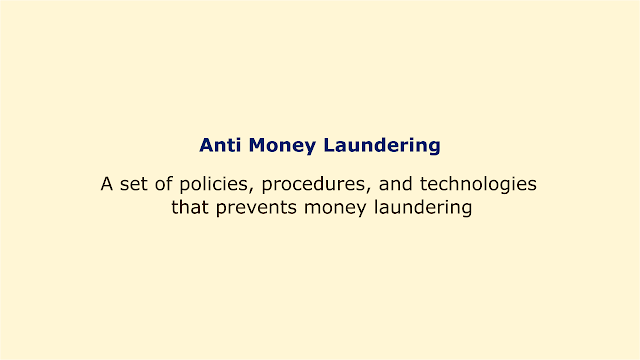 |
| Image: Moneybestpal.com |
Anti Money Laundering (AML) refers to a collection of guidelines, practices, and technological advancements that stop money laundering. Money laundering is the practice of disguising an item's illicit source by passing it through a number of transactions and organizations to make it seem legitimate.
Crimes including tax evasion, drug trafficking, corruption, and terrorism can all be made easier by money laundering.
Money laundering involves three main steps: placement, layering, and integration. The process of placing illegal funds into the financial system includes actions like putting cash into a bank account or purchasing a money order. By moving money between accounts or jurisdictions, using shell corporations or trusts, or any other method, layering is the process of hiding the source and ownership of the money. The stage of integration occurs when the money is returned to the economy as legitimate income, such as through the acquisition of real estate, financial assets, or business ventures.
In order to prevent money laundering, a number of rules and regulations have been passed requiring financial institutions and other organizations to monitor their customers' transactions, undertake due diligence on them, and report any suspicious activity to the police. These actions are referred to as anti-money-laundering measures (AML). Some examples of AML regulations are:
Financial institutions and other organizations that deal with money need to comply with AML regulations on a business and a legal level. An organization's reputation and integrity can be safeguarded, fines and penalties can be avoided, criminal exploitation can be stopped, and consumer trust and loyalty can be increased.
Money laundering involves three main steps: placement, layering, and integration. The process of placing illegal funds into the financial system includes actions like putting cash into a bank account or purchasing a money order. By moving money between accounts or jurisdictions, using shell corporations or trusts, or any other method, layering is the process of hiding the source and ownership of the money. The stage of integration occurs when the money is returned to the economy as legitimate income, such as through the acquisition of real estate, financial assets, or business ventures.
In order to prevent money laundering, a number of rules and regulations have been passed requiring financial institutions and other organizations to monitor their customers' transactions, undertake due diligence on them, and report any suspicious activity to the police. These actions are referred to as anti-money-laundering measures (AML). Some examples of AML regulations are:
- The Bank Secrecy Act (BSA) of 1970 in the United States mandates that banks and other financial institutions maintain records of cash transactions over $10,000 and report them to the Financial Crimes Enforcement Network (FinCEN), as well as file Suspicious Activity Reports (SARs) for any transactions that may be indicative of money laundering or other criminal activity.
- The European Union's Money Laundering Directive (MLD), which was adopted in 1991, stipulates the basic requirements for AML compliance for each member state, including the need for client identification and verification, record-keeping, and the reporting of suspicious activities.
- The Financial Action Task Force (FATF) Guidelines of 1990 are a series of global guidelines for anti-money laundering (AML) and counter-terrorism financing (CTF) that have been endorsed by more than 200 nations and jurisdictions. The FATF Guidelines address a number of AML/CTF-related topics, including institutional structures, legislative frameworks, preventative measures, international collaboration, and sanctions.
Financial institutions and other organizations that deal with money need to comply with AML regulations on a business and a legal level. An organization's reputation and integrity can be safeguarded, fines and penalties can be avoided, criminal exploitation can be stopped, and consumer trust and loyalty can be increased.
